In 2025, NABERS expanded its influence and amplified its impact. New tools, partnerships and policies drove strong growth in ratings, while operational improvements reinforced confidence in the system’s credibility, consistency and useability. Industry leadership in electrification, embodied carbon and net zero commitments drove progress, with NABERS providing the backbone for transformation.
FY25 highlights
NABERS continues to drive transformative growth and collaborative innovation, opening the door to diverse sectors and expanding our reach.
- Record growth in certifications: 120% increase in certified ratings compared to FY24, led by public school portfolio assessments across multiple jurisdictions (3,500 ratings) and a 40% rise in Hotel ratings
- Launch of NABERS Embodied Carbon tool: A new benchmark enabling measurement of upfront embodied carbon, supported by rules, a national database, a calculator and trained assessors
- Sustainable Portfolios Index expansion: 67 portfolios across 30 companies and 500-plus assets, with 20 hotels joining for the first time and new indicators for renewable energy and electrification
- Sustainable finance: NABERS supported the launch of Australia’s Sustainable Finance Taxonomy and released version 2 of the NABERS Sustainable Finance Criteria, helping align buildings with green investment benchmarks and streamlining access to sustainability-linked finance
- Operational excellence: 11,000 ratings certified in FY25 (98% within 10 days), 86 new Assessors onboarded, and streamlined processes through NABERS Perform
- Co-Assess expansion to Shopping Centres: Supporting sector leaders and streamlining the rating lodgement process to increase efficiency for both Assessors and NABERS internal tea
- Hotels sector recognition: NABERS Hotel ratings now visible on Google Travel with an “eco-certified” tag and accepted by Travalyst’s global sustainability platform
- International growth: NABERS UK relaunched with strong uptake (42 new Design for Performance projects, 92 Assessors), while NABERS NZ grew 14% in Energy ratings and launched a Water rating tool for offices.
Over the past two decades, NABERS has helped customers save:
- $2.23 billion in energy bills and
- 15.48 million tonnes of CO2 emissions.
Key figures:
- 87% increase in Data Centre ratings
- 44% increase in Warehouses and Cold Store ratings
- 33% increase in Apartment buildings ratings
- 55% of total ratings came from first time NABERS raters
- 40% increase in certified Hotel ratings
- 7% increase in Office ratings, including 27% increase in Office Waste
- 5% increase in Shopping Centre Energy and Water ratings
- 1st NABERS Energy Performance Indicator certification for a childcare centre.
Money meets measurement: NABERS in the market
With the Sustainable Portfolios Index setting new performance standards and the Australian Sustainable Finance Taxonomy embedding NABERS, ratings enhance both credibility and access to capital.
More portfolios, more firsts: Sustainable Portfolios Index 2025
This year’s Sustainable Portfolios Index charted 67 property portfolios across 30 companies, covering more than 500 assets. For the first time, hotels joined the Index, with CapitaLand and the Schwartz Family Company representing around 6,000 rooms, alongside offices and shopping centres.
The SPI unveiled a new Renewable Energy Indicator, with some portfolios achieving close to 100% renewable energy and 99% electrification across their assets. Three shopping centre portfolios reached full carbon neutral coverage.
Together, these results confirm the SPI’s role as a benchmark for transparency and high performance, showcasing the leadership of Australia’s property owners in the net zero transition.
From ratings to returns: NABERS underpins sustainable finance
The Australian Sustainable Finance Taxonomy – a voluntary, Paris-aligned framework that defines sustainable and transition activities – launched on 17 June 2024. For investors, it sets clear benchmarks. For building owners, it opens a direct route to green capital.
NABERS played a central role, contributing our data and helping to create proxies so building owners can use their NABERS ratings to demonstrate alignment with the Taxonomy’s climate mitigation criteria. This is a strong first step, and we anticipate guidance on water, waste and emerging sectors to follow.
The Australian Sustainable Finance Taxonomy in practice:
- Links directly to NABERS ratings, so building owners can provide structured evidence of sustainable operations
- Unlocks access to green loans and sustainability-linked finance
- Offers market leading opportunities to shape the future of sustainable finance in Australia.
Building on this momentum, version 2 of the NABERS Sustainable Finance Criteria was launched in June 2025. Developed with lenders nationwide, the updated version includes revised targets, new building sectors, and additional rating types to meet market demand. The result is more robust benchmarks for green lending in the built environment.
Sector engagement update: New pathways, greater visibility
From hotels and apartments to warehouses and schools, NABERS is expanding the map of sustainability across the country, charting new pathways, new partnerships and greater visibility.
Hotels
Global visibility
NABERS ratings now reach millions of travellers when they consider hotel bookings. NABERS Hotels certifications are recognised by Travalyst, which brings together the world’s biggest travel platforms to put sustainability at the heart of booking decisions. On Google Travel, hotels with NABERS certifications carry an “Eco-certified” tag. Work is underway to secure recognition on more booking sites.
Stronger partnerships
NABERS has partnered with tourism sustainability certification schemes EarthCheck, Ecotourism Australia and Green Key. NABERS Energy and Water ratings or Waste verification reports can be used by hotel and short-stay accommodation providers to demonstrate compliance with these schemes. Our work together is reducing duplication, streamlining certification pathways and empowering hotel operators to demonstrate sustainability leadership.
Apartments
Exploring electrification
NABERS and the ACT Government have worked together to explore electrification opportunities at 15 residential strata buildings in Canberra. The project tested energy and water efficiency and mapped the potential for existing fossil gas systems to be replaced.
We found many buildings achieved 5 or 6 star NABERS Energy ratings, thanks to design features like decentralised ventilation systems, individual air-conditioning units and efficient car park ventilation. Water ratings were more tightly clustered around 4 stars.
Every building relied on centralised gas hot water – a challenge for electrification due to space and structural constraints. Even so, several buildings could upgrade to high-efficiency systems or heat pumps, particularly where rooftop or adjacent space is available. Most buildings already use electric cooktops, and some pools are heated by electric or solar systems. All buildings relied on reverse cycle air-conditioning, rather than gas, for space heating.
The study acknowledged a known limitation in the NABERS for Apartments Energy Rating tool, where gas powered centralised hot water was not reflected in the energy profile, resulting in inaccurate Renewable Energy Indicator scores. Thanks to State, Commonwealth & Territory Government funding secured for this year, the NABERS for Apartments tool will be updated making it possible to include centralised gas hot water profiles in future Energy Ratings. Allowing for enhanced visibility of buildings that are reliant on gas, which is an issue of importance for jurisdictions that are phasing out fossil-fuel gas use.
Overall, the project provides valuable insights into building performance and practical pathways for strata buildings to make the electric switch.
Warehouse and cold stores
Engaging the supply chain
Warehouses and cold stores sector are among the most energy-intensive sectors in the built environment, and central to the supply chain. Over the past year, NABERS has stepped up its engagement with the sector to drive efficiency and cut emissions.
The Supply Chain & Logistics Association of Australia (SCLAA) has joined the NABERS National Steering Committee, bringing deep expertise and giving the sector a direct voice.
On the industry stage
Over the year, the NABERS team engaged in new industry conversations at some of the biggest supply chain and logistics conferences, including CeMAT, MegaTrans and ATMOsphere Australia. We connected directly with logistics leaders, showcased the value of NABERS ratings, and highlighted how sustainability performance can drive operational efficiency and competitiveness.

Image: CeMAT 2024

Image: ATMOsphere 2025
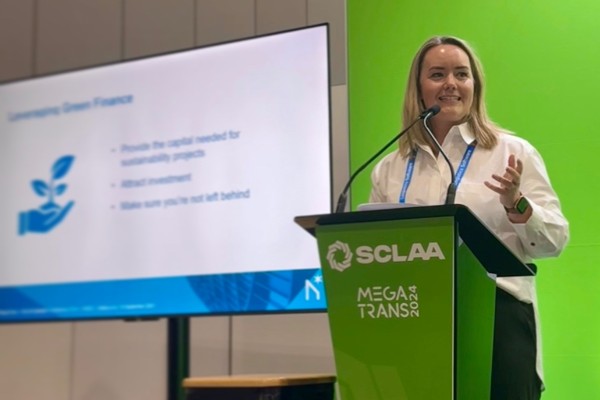
Image: MegaTrans 2024
Sector expansion: Straighter pathways, sharper signals
This year NABERS expanded its reach with new tools, updated benchmarks and more intuitive technology platforms that make it easier for industry to measure, compare and improve the performance of buildings.
Co-Assess for Shopping Centres
Smarter ratings, shared effort
Co-Assess allows base building and multiple tenancy ratings to be assessed, visited, submitted and certified in one streamlined lodgement, with individual NABERS certificates issued for each space rated.
Expanding reach
Co-Assess for Offices was launched in 2016 and moved from an Excel-based lodgement onto the Perform platform in 2025. At the same time, Co-Assess for Shopping Centre and Retail Stores was launched in May, giving owners and tenants a faster, more collaborative way to secure NABERS ratings.
Engaging industry
Various briefings and a customer webinar brought together NABERS Assessors, building owners and the NABERS team to showcase efficiencies, share lessons and highlight the benefits of working together to elevate sustainability outcomes in retail environments.
Embodied carbon
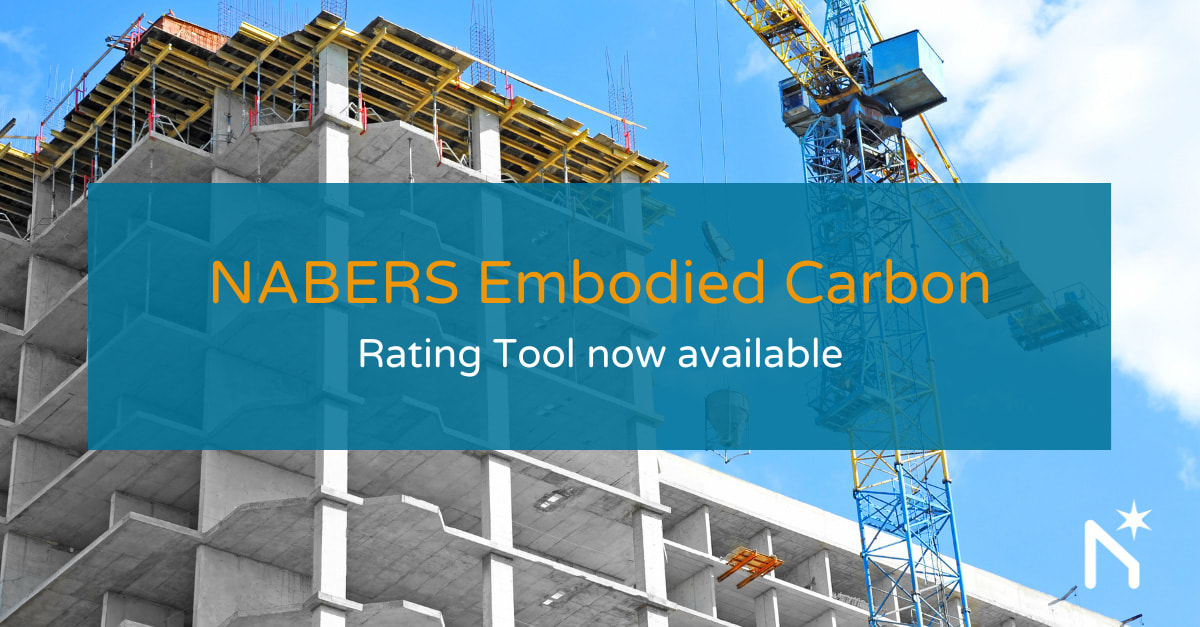
A new benchmark
The NABERS Embodied Carbon tool was launched in November 2024 by the Hon Josh Wilson, federal Assistant Minister for Climate Change and Energy, at the Energy Efficiency Council’s Building Energy Performance Summit.
Australia’s built environment industry now has a standard way to measure and compare upfront carbon emissions in new builds and partial rebuilds, addressing a long-standing challenge where companies relied on different methods, making results impossible to compare or regulate.
At the heart of the tool are new rating rules. These define which materials must be included in a NABERS Embodied Carbon rating, what emission factors to use, and what evidence is appropriate to prove accuracy. By providing a standardised methodology, the rules give project teams confidence to estimate, plan and deliver carbon reductions, and enable policymakers to set credible targets for the first time.
As part of the collaborative development process, NABERS has rolled out:
- National material emission factors database: A reliable source of product emission factors, regularly updated.
- Rating calculator: Publicly available to help project teams estimate, model and plan for carbon reduction.
- Assessor training: More than 100 participants in FY25 create a growing pool of qualified practitioners.
- Benchmark: A 6-star embodied carbon rating scale, finalised in March 2025 after close industry consultation.
Sector alignment
Developed with industry and international standards, NABERS Embodied Carbon has been backed by the Green Building Council of Australia. Green Star Buildings v1.1 is set to align with the NABERS methodology, giving the market confidence that embodied carbon is measured consistently nationwide.
NABERS Energy benchmark update
NABERS Energy benchmarks are updated every five years to reflect the latest National Greenhouse Accounts (NGA) emissions factors – the Australian Government’s official emissions data for energy use.
The 2025 update, based on 2024 NGA factors, captures the growing share of renewables in the grid. As the grid decarbonises, ‘carbon per kilowatt-hour’ will no longer be a reliable performance signal. Consequently, the final update to the NABERS Energy benchmarks is planned for 2030.
To help our stakeholders to prepare, we have released a new set of prediction tools to show how ratings will evolve, as follows:
- 1 July 2025: Ratings based on the 2024 NGA factors, applying to periods after 30 June 2024.
- 1 July 2021 to 30 June 2025: Estimated ratings for periods starting between 1 July 2020 and 30 June 2024.
- Pre-1 July 2021: Estimated ratings for periods starting before 1 July 2020.
The prediction tools help stakeholders explore how ratings may change over time, offering clarity on the 2025 update and possible 2030 scenarios.
NABERS Perform
A platform for progress
With funding from the Australian Government and input from assessors and customers, the NABERS Perform technology platform is the new backbone of the rating system.
Over the last year, NABERS Perform has expanded rapidly. New features make data entry easier, calculations more accurate and certification more efficient.
New tools added
Among the swathe of new rating tools added to the platform this year, NABERS Embodied Carbon ratings can now be lodged and certified, and shopping centre owners can concurrently certify their assets alongside rateable retail stores using Co-assess for Shopping Centres and Retail Stores.
Both NABERS Energy and Water for Apartment Buildings and Co-assess for Offices were migrated to NABERS Perform streamlining the rating lodgement process for Assessors and enhancing internal efficiencies.
The NABERS Rating Progress Metric is now visible on all rating certificates and reports, helping customers track their progress towards the next half star.
Policy and partnerships: From ambition to action
Policy settings are shifting and NABERS data, tools and expertise are making sure ambition translates into action.
CBD consultation
From June to September 2024, the Australian Government consulted on expanding the Commercial Building Disclosure (CBD) Program. NABERS contributed by working collaboratively with the CBD team, responding to industry queries and presenting at consultation webinars to ensure customers and Assessors understand how NABERS ratings work. NABERS data confirms buildings covered by the CBD Program improved their energy intensity by 29% over 12 years, and KPMG analysis has found expanding the Program is the most effective way to cut commercial building emissions and reach net zero by.
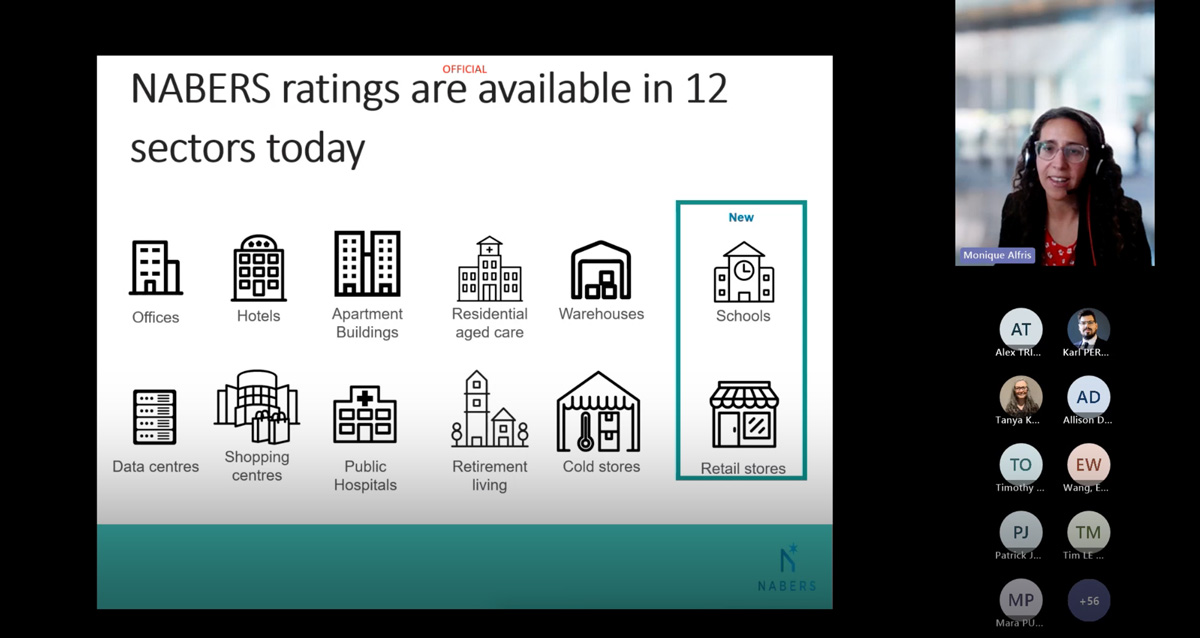
Image: Monique Alfris, A/ NABERS Director, presenting at the CBD consultation webinar
NSW Net Zero Government Operations
The NSW Government’s Net Zero Government Operations Policy, released in December 2024, lifts the bar for sustainable government buildings. NABERS requirements now include:
- Office Energy ratings rising from 5 stars to 5.5 stars by June 2026, and 6 stars by June 2030
- Office Water ratings increasing from 4 stars to 5 stars by June 2026
- New targets of 4 star Office Waste ratings and 4.5 star Office Indoor Environment ratings by 30 June 2026, increasing to 6 and 5 stars respectively by 30 June 2030.
The policy also commits to rating all eligible public schools and preschools with NABERS Energy and Water ratings over a three-year period, as well as a plan to display NABERS Hotel ratings in the NSW Government booking system.
Home Energy Ratings Disclosure Framework
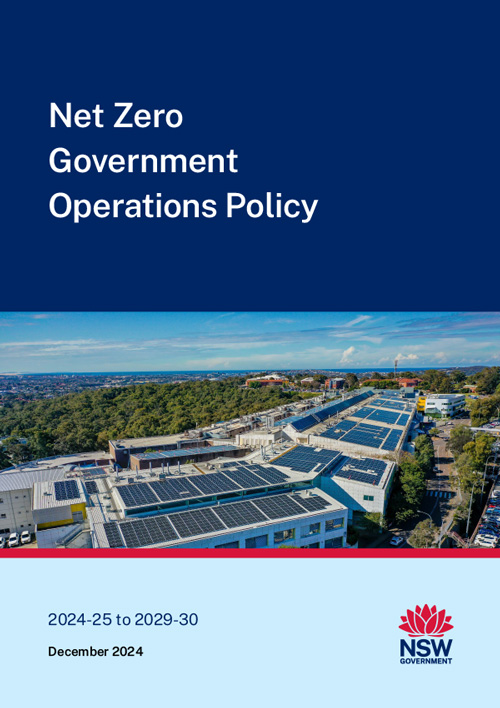
Energy Ministers released the Home Energy Ratings Disclosure Framework Version 1 in July 2024, which sets out a national approach to residential disclosure schemes. Version 2, expanded to include apartment buildings, was released in December 2024. This uses the NABERS Apartment Buildings rating tool to assess common areas.
Trajectory for Low Energy Buildings
NABERS has worked with the federal, state and territory governments to update the national pathway to zero energy and low carbon buildings by 2050. NABERS ratings are recognised as a key mechanism to enhance operational performance and, for the first time, to drive embodied carbon measurement.
NABERS international: Global growth, local gains
From the UK’s first 5.5-star Energy rating to New Zealand’s new Water for Offices rating tool, NABERS is proving its value as a global benchmark for building performance.
NABERS UK
CIBSE Certification Ltd, NABERS UK new administrator, officially relaunched the scheme in July 2024 and has delivered an impressive first year: 42 new Design for Performance registrations, 14 Energy for Offices certifications, 92 Assessors licensed and 70 new trainees.
A highlight was the UK’s first 5.5 star Energy rating, awarded to Watkins Payne’s Surrey office, and a milestone that demonstrates the market’s appetite for higher performance.
While Design for Performance growth has been steady since NABERS UK began in 2020, this past year’s focus has been on supporting CIBSE, the Better Buildings Partnership (BBP) and the NABERS UK Steering Committee to expand uptake of ratings. Another priority has been aligning NABERS UK with the new groundbreaking, industry-led Net Zero Carbon Building Standard.
NABERS New Zealand
The New Zealand Green Building Council reported a 14% increase in NABERS NZ Energy for Offices ratings in FY25, certifying 174 in total. The NABERS NZ Water for Offices rating tool also launched, making it possible for building owners to rate both energy and water.
The Energy Efficiency and Conservation Authority (EECA) achieved its first tranche of Energy and Water ratings for public hospitals. The EECA commissioned a sector expansion analysis report, to guide future coverage of other building types – a key focus for the year ahead.
The NABERS engine room
From strengthening rules and systems to investing in Assessors and staff, NABERS is building the capability and culture to support faster growth and deeper impact.
Training
Assessor capability goes from strength to strength. More than 90 Assessors gained accreditation in our NABERS Energy Performance Indicator, following our August 2024 webinar, and another 70-plus Assessors were accredited in the NABERS Embodied Carbon tool since April 2025. A further 86 trainees joined our community as newly-accredited Assessors.
Operations
We reinforced our foundations this year – refining rules, streamlining processes and upgrading training and auditing systems to prepare for future growth. Key activities included:
- Updated NABERS Rules across multiple sectors to enable tool migrations to NABERS Perform and streamline data entry.
- Enhanced training delivery, with 400-plus course enrolments and 86 new Assessors joining the program.
- Refreshed accreditation courses for Hotels and Shopping Centres, Co-assess training, and new auto-response systems for exam feedback.
- Revisions to auditing policy and procedures to prepare for future growth.
Looking ahead, our priorities include embedding the revised audit policy, refining standards and guidance, strengthening training, expanding automated support and investing in internal technical capability.
FY25 key highlights
- 11,000 ratings certified
- 98% of certifications achieved within 10 days of submission
- 189 audits undertaken, achieving our L2 audit target of 5%
- 6,700 cases closed
- 86 Assessors onboarded.
Staff engagement
The strength and success of NABERS comes down to people – our customers, industry partners, Assessors and a team recognised across the built environment for their technical expertise, collaborative approach and commitment to decarbonisation.
Our people are not just administrators of a rating system. They are working side-by-side with industry to translate ambition into measurable progress.
In FY25, NABERS staff contributed to industry panels, government consultations and cross-sector forums alongside industry leaders from the Property Council of Australia, the Green Building Council of Australia, the Energy Efficiency Council, the Australian Sustainable Built Environment Council and more.
These conversations reinforce NABERS’ role in Australia’s net zero transition, and ensure our tools remain technically robust and practically relevant to the people who use them every day.



Key highlights:
- 30 industry conferences and events featured NABERS staff presentations
- 14,000 LinkedIn followers, an increase of 2,000 in FY25
- 139,149 people engaged through direct email campaigns (up 33% from FY24)
- 550 people engaged through a host of online events on everything from hotels to data centres, and with industry associations, asset owners and government partners
- 2,000 people engaged through industry expos: MegaTrans 2024, CeMAT 2024, ATMOsphere 2025, FMA Summit in Perth, NZGBC Summit in Auckland, the GBCA’s national Green Building Days, NoVacancy Hotel & Accomodation Expo, TRANSFORM 2025, Energy Efficiency Council National Conference, the Whole of Australia Government Travel Sustainability Forum and more.
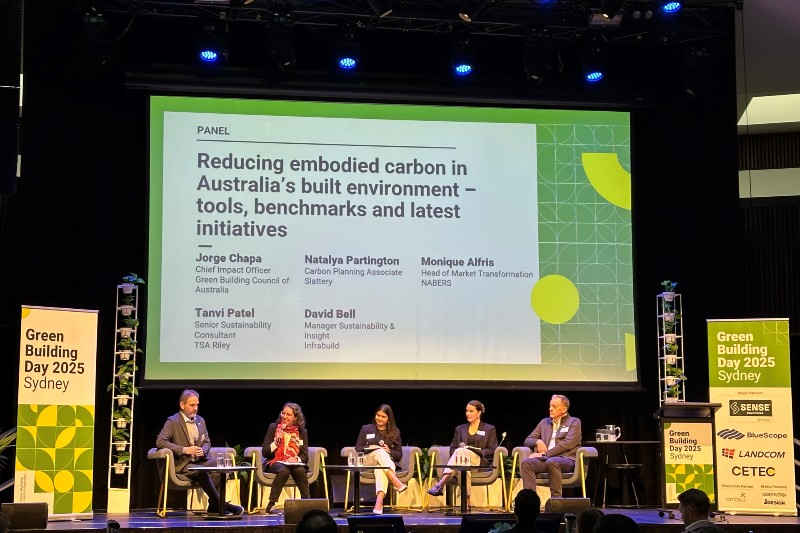
Image: Monique Alfris, Green Building Council of Australia Green Building Day, June 2025

Image: Carlos Flores, Energy Efficiency Council National Conference, May 2025
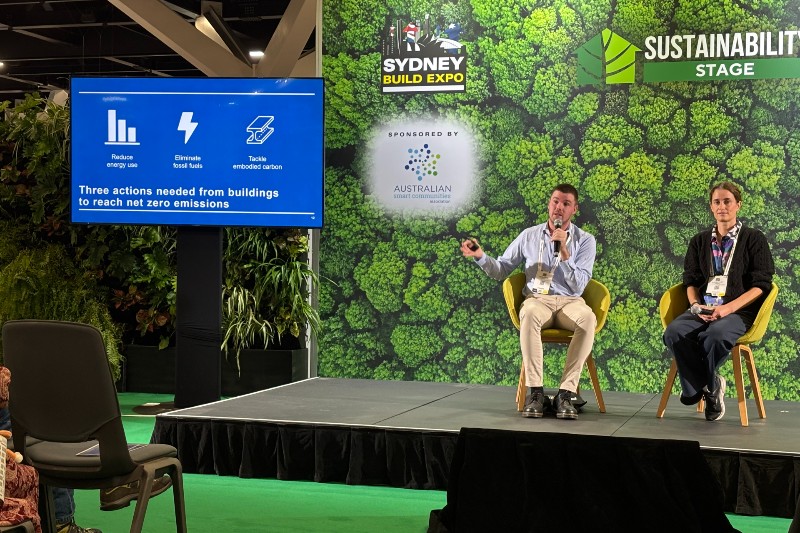
Image: Ryan Flack and Katie Eyles, Sydney Build Expo, May 2025

Image: Carlos Flores, TRANSFORM 2025, March 2025

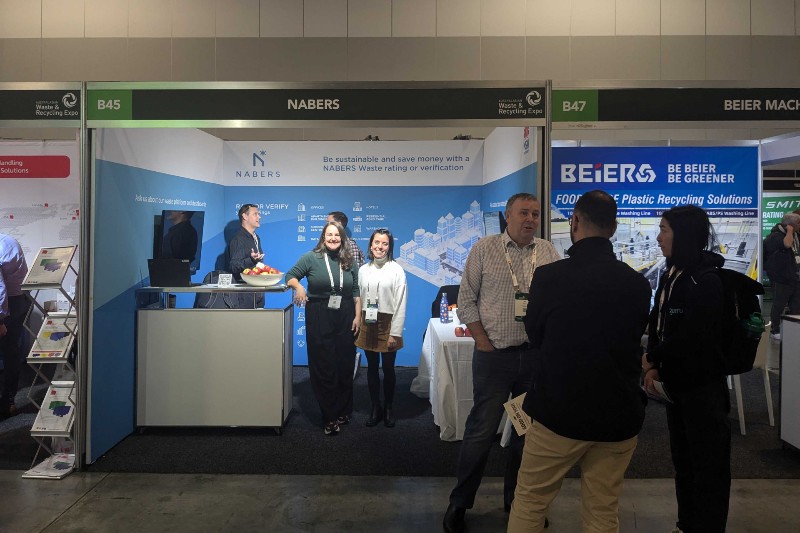
Image: Alexandra Lomo and Macarena Calisto Ovalle, Australasian Waste & Recycling Expo, July 2024

Image: Sara Levett, Australasian Waste & Recycling Expo, July 2024
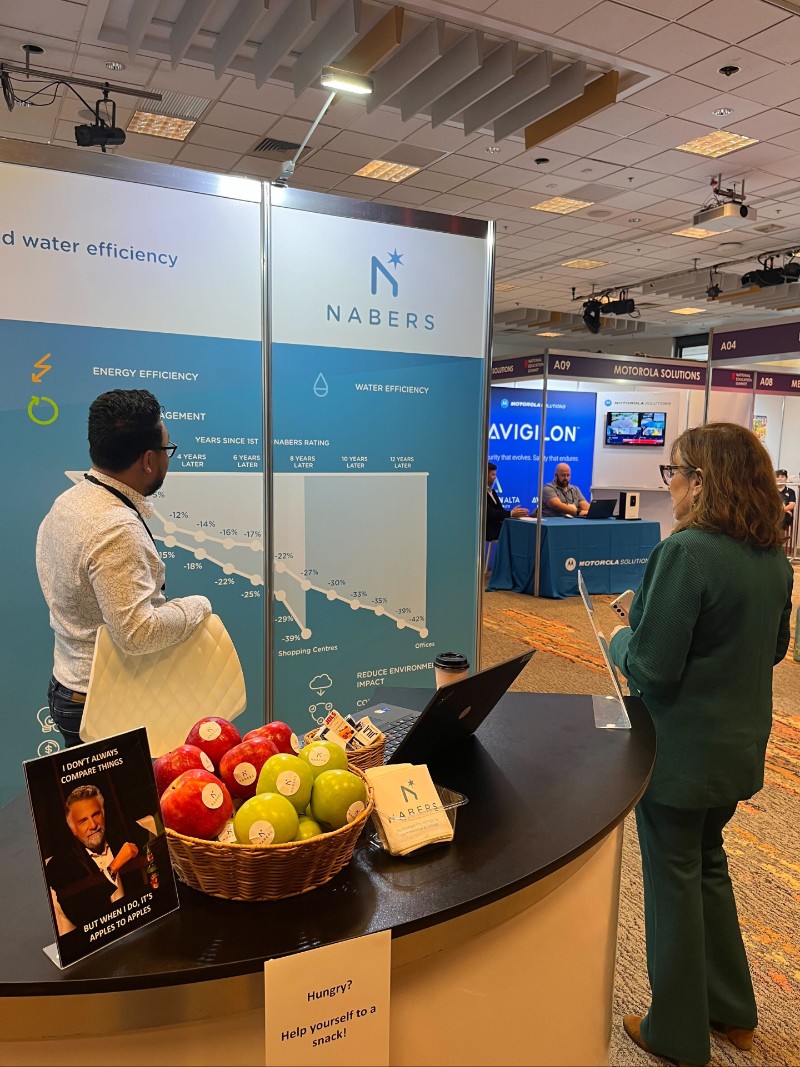
Image: Andy Buchel, National Education Summit, 31 August 2025
